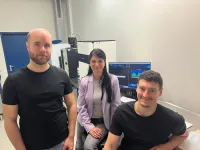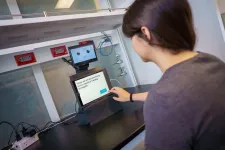(Press-News.org) The National Institutes of Health (NIH) has partnered with the U.S. National Science Foundation (NSF) to provide approximately $15.4 million over three years for research into the structures, functions and interactions of ribonucleic acid (RNA), as well as the creation of RNA-based technologies. RNA sequencing and the mapping of RNA modifications have gained significant momentum in the genomics community in recent years, with a new report from the National Academies of Sciences, Engineering, and Medicine outlining a roadmap for the field to build technology and infrastructure to allow researchers to more completely study and catalog RNA and its modifications.
“A deeper understanding of RNA and its potential applications can advance our knowledge of living systems and can have profound impacts on human health.” said Carolyn Hutter, Ph.D., director of the Division of Genome Sciences at the National Human Genome Research Institute, part of NIH.
NIH will provide approximately $2.7 million, pending availability of funds, to support the work of two research groups while NSF has awarded over $12.7 million among nine research groups through NSF’s Molecular Foundations for Biotechnology program.
The NIH-funded projects include:
A research team at the University of Massachusetts, Amherst, will focus on synthesizing long RNA molecules using a microfluidics platform, which consists of miniature chambers through which fluids are moved or stored. Scientists use long RNA molecules to probe genomic pathways and develop new drugs, but they can be difficult to synthesize because of their unstable nature. Current methods may not be able to produce high quantities of molecules with the correct sequences and structures. The group aims to develop a platform for synthesizing long, designer RNA molecules that maintain their correct folded structures, opening new avenues for scientific research.
A scientific team at the University of Michigan, Ann Arbor, will expand the capabilities of two technologies called nanopore sequencing and mass spectrometry, enabling researchers to determine the sequence of any RNA molecules, including those containing modifications that are difficult to detect. Cells chemically modify RNA molecules to change their formation, function, stability and location, which can affect important processes such as protein production and biological transition into different cell types. While RNA modifications have been implicated in a variety of human disorders and diseases, researchers are still trying to understand how each modification affects RNA function. The group will study modifications of several types of RNA in yeast, humans and a single-cell organism known as T. kodakarensis.
"Discoveries about RNA and its applications in the last several decades have transformed the field of science and medicine,” said Ian Nova, Ph.D., program director in NHGRI’s Division of Genome Sciences. “Our continued exploration of RNA and its associated innovations will inevitably shape the future of biomedicine.”
RNA is a molecule that is in all living cells and plays a role in nearly all biological processes, including carrying instructions for making proteins, helping build proteins and turning genes on and off. While RNA was discovered over a century ago, researchers are still uncovering new RNA-related pathways and RNA structures. Recent scientific advances have harnessed RNA to develop technologies and therapeutics such as small interfering RNA-based drugs and messenger RNA-based vaccines against cancers and infectious diseases.
END
NIH and National Science Foundation to award $15.4 million for RNA research
Funding to advance understanding of RNA biology and development of RNA-based technologies
2024-06-24
ELSE PRESS RELEASES FROM THIS DATE:
Study examines acceptability of teleneurology across neurological conditions
2024-06-24
INDIANAPOLIS – One of the first studies to examine patient acceptability of teleneurology and determine factors influencing acceptability across neurological conditions, has found teleneurology was highly acceptable across the full range of patients with different neurological diagnoses, including headache, movement disorders and other neurological symptoms and diagnoses. The study also determined that the more medical complexity -- having additional diseases -- was associated with increased patient satisfaction with teleneurology.
Older patients were as accepting of teleneurology as younger patients, individuals often viewed as more ...
Correcting biases in image generator models
2024-06-24
Image generator models – systems that produce new images based on textual descriptions – have become a common and well-known phenomenon in the past year. Their continuous improvement, largely relying on developments in the field of artificial intelligence, makes them an important resource in various fields.
To achieve good results, these models are trained on vast amounts of image-text pairs – for example, matching the text "picture of a dog" to a picture of a dog, repeated millions of times. Through this training, ...
How cells boost gene expression
2024-06-24
The function of non-coding RNA in the cell has long been a mystery to researchers. Unlike coding RNA, non-coding RNA does not produce proteins – yet it exists in large quantities. A research team from the University of Göttingen has now discovered an important function of antisense RNA (asRNA): the researchers found that asRNA acts as a "superhighway" in cell transport and thus accelerates gene expression. The results were published in Nature.
RNA (ribonucleic acid) plays a central role in the translation of DNA information into proteins. There are different types of RNA, one of which is known as messenger ...
Meet CARMEN, a robot that helps people with mild cognitive impairment
2024-06-24
Video: https://youtu.be/bGKA32TlVXM?si=0PdhaUyOKH33DFbB
Meet CARMEN, short for Cognitively Assistive Robot for Motivation and Neurorehabilitation–a small, tabletop robot designed to help people with mild cognitive impairment (MCI) learn skills to improve memory, attention, and executive functioning at home.
Unlike other robots in this space, CARMEN was developed by the research team at the University of California San Diego in collaboration with clinicians, people with MCI, and their care partners. To the best of the researchers’ knowledge, CARMEN is also the only robot that teaches compensatory cognitive strategies to help improve memory and executive function.
“We ...
NYU creates Center for Mind, Ethics, and Policy
2024-06-24
New York University has established the Center for Mind, Ethics, and Policy, which aims to further our understanding of the sentience and moral status of nonhumans, notably animals and AI systems.
“The world contains quintillions of animals, and in the future, it could contain an even larger number of AI systems,” says Jeff Sebo, CMEP’s founding director and a professor in NYU’s Department of Environmental Studies. “Human activity is increasingly shaping the lives of these beings, and these trends raise important and difficult questions, such as: Which of these beings are sentient, ...
New mathematical proof helps to solve equations with random components
2024-06-24
Whether it’s physical phenomena, share prices or climate models – many dynamic processes in our world can be described mathematically with the aid of partial differential equations. Thanks to stochastics – an area of mathematics which deals with probabilities – this is even possible when randomness plays a role in these processes. Something researchers have been working on for some decades now are so-called stochastic partial differential equations. Working together with other researchers, Dr. Markus Tempelmayr ...
Researchers awarded $2.78M federal grant to improve rectal cancer treatment with artificial intelligence
2024-06-24
CLEVELAND—With a new five-year, $2.78 million grant from the National Institutes of Health and National Cancer Institute, researchers at Case Western Reserve University(CWRU), Cleveland Clinic and University Hospitals (UH) will use artificial intelligence (AI) to better treat rectal cancer patients.
The American Cancer Society estimates about 46,000 people nationally will be diagnosed this year with rectal cancer—the third most common type of cancer in the digestive system, after colon and pancreatic cancer.
By using AI, the researchers intend to derive specific metrics on magnetic resonance imaging (MRI) scans to better understand how ...
Manipulating the frequency of terahertz signals through temporal boundaries
2024-06-24
Terahertz technology could help us meet the ever-increasing demand for faster data transfer rates. However, the down-conversion of a terahertz signal to arbitrary lower frequencies is difficult. In a recent study, researchers from Japan have developed a new strategy to up- and down-convert a terahertz signal in a waveguide by dynamically modifying its conductivity using light, creating a temporal boundary. Their findings could pave the way to faster and more efficient optoelectronics and enhanced telecommunications.
As we plunge deeper into the Information Age, the demand for faster data transmission keeps soaring, accentuated by fast progress in fields like deep learning ...
Study links neighborhood violence, lung cancer progression
2024-06-24
CHAMPAIGN, Ill. — Scientists have identified a potential driver of aggressive lung cancer tumors in patients who live in areas with high levels of violent crime. Their study found that stress responses differ between those living in neighborhoods with higher and lower levels of violent crime, and between cancerous and healthy tissues in the same individuals.
The findings are detailed in the journal Cancer Research Communications.
The study was designed to address the higher incidence of lung cancer in Black men than in white men, said University of Illinois Urbana-Champaign ...
Philadelphia social entrepreneurs address root causes of community violence
2024-06-24
PHILADELPHIA, June 24, 2024 — About 80% of an individual’s modifiable health contributors are determined by social and economic factors.[1] Exposure to violence can have detrimental health implications contributing to toxic stress and trauma, mental health illness, substance abuse and an increased risk for heart disease[2].
The American Heart Association, which marked 100 years of service saving lives earlier this month, has distributed $480,000 from the Association’s Bernard J. Tyson Impact Fund to four social ...
LAST 30 PRESS RELEASES:
Heart-brain connection: international study reveals the role of the vagus nerve in keeping the heart young
Researchers identify Rb1 as a predictive biomarker for a new therapeutic strategy in some breast cancers
Survey reveals ethical gaps slowing AI adoption in pediatric surgery
Stimulant ADHD medications work differently than thought
AI overestimates how smart people are, according to HSE economists
HSE researchers create genome-wide map of quadruplexes
Scientists boost cell "powerhouses" to burn more calories
Automatic label checking: The missing step in making reliable medical AI
Low daily alcohol intake linked to 50% heightened mouth cancer risk in India
American Meteorological Society announces Rick Spinrad as 2026 President-Elect
Biomass-based carbon capture spotlighted in newly released global climate webinar recording
Illuminating invisible nano pollutants: advanced bioimaging tracks the full journey of emerging nanoscale contaminants in living systems
How does age affect recovery from spinal cord injury?
Novel AI tool offers prognosis for patients with head and neck cancer
Fathers’ microplastic exposure tied to their children’s metabolic problems
Research validates laboratory model for studying high-grade serous ovarian cancer
SIR 2026 delivers transformative breakthroughs in minimally invasive medicine to improve patient care
Stem Cell Reports most downloaded papers of 2025 highlight the breadth and impact of stem cell research
Oxford-led study estimates NHS spends around 3% of its primary and secondary care budget on the health impacts of heat and cold in England
A researcher’s long quest leads to a smart composite breakthrough
Urban wild bees act as “microbial sensors” of city health.
New study finds where you live affects recovery after a hip fracture
Forecasting the impact of fully automated vehicle adoption on US road traffic injuries
Alcohol-related hospitalizations from 2016 to 2022
Semaglutide and hospitalizations in patients with obesity and established cardiovascular disease
Researchers ‘listen in’ to embryo-mother interactions during implantation using a culture system replicating the womb lining
How changing your diet could help save the world
How to make AI truly scalable and reliable for real-time traffic assignment?
Beyond fragmented markets: A new framework for efficient and stable ride-pooling
Can shape priors make road perception more reliable for autonomous driving?
[Press-News.org] NIH and National Science Foundation to award $15.4 million for RNA researchFunding to advance understanding of RNA biology and development of RNA-based technologies





